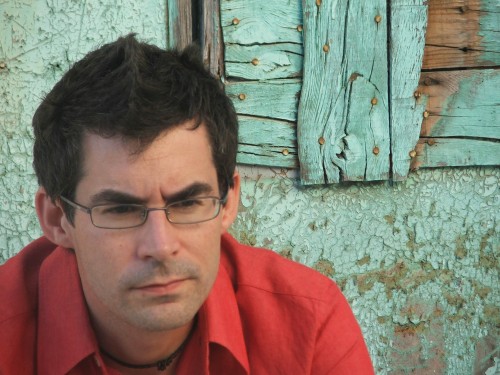
Julián Cañizares Mata (Albacete, 1972) has published Travis poemas (Colección Provincia, Diputación de León, 1999); Los elementos del clima (The Elements of Climate) at Editorial Aventis, 1999; El hombre sin cabeza, el gato Wilson y el Condotiero Fajardo (The Headless Man, Wilson the cat and the Condottiero Velasco) in the book Tres tipos con gafas (Three guys with glasses), Academia de Samotracia, 2001; and Sustituir estar (Substitute being), Ediciones DVD, 2009. He is the director of the literary magazine Ayvelar. He continues writing.
How would you define yourself?
As a guy with glasses who loves to think in poems. And that looks for the poems that he can find lying around. Poems are not hidden, but waiting to be found in streets and terraces, in the gestures that things make and in everything that breathes, as well as in other poems. Once found, this guy with glasses writes them down at home, reads them quietly, and then goes out for another walk to find more poems lying around. And so on and so forth…
What can the audience expect from your collaboration with Spain NOW!?
I hope they can find an interesting way of understanding a poem. And by interesting I mean thought-provoking and, if possible, even personal.
What do you think your collaboration with Spain NOW! will bring for you?
The great satisfaction of working with other creative people, in this case Silvia Terrón, Pablo Gallo and Terence Dooley. For me poetry is not only the action of a lonely guy with his lonely thoughts in a lonely room. I also like to “write on demand”, based on someone else’s idea, or translation, that turns my poem in a new creation, in a new finding. Writing poems has to be much more than my individual influence upon them.
Describe or give us some insights about your creative process.
Each poem tends to have a different nuance in its creative process. In the case of “Landscape”, the process was as follows: Pablo Gallo sent me the images of a series of paintings in which he was working, which had a strong poetic quality to them, which almost asked for texts. From there we took ideas, words, sentences and let them ripen until I felt an urge to sit down and write. I wrote five poems, and then Pablo chose one of them and the result was “Landscape”.
Where have you shown internationally before? And in Spain?
This is the first time I participate in an international project. In Spain I have taken part in readings and literary magazines as well as poetry festivals such as Cosmopoética in Córdoba or Fractal in Albacete.
What can you say about the current state of Spanish culture within your field?
Spanish poetry is currently in a good moment (as always?). There are many of us who write, and we have a wide scope of influences, both poetic (there are more and more translations, which are crucial to develop a personal and unique voice) and visual, creative, etc. The result is that today there are very different ways of understanding a poem. And diversity makes poems richer. There are some poetic trends that predominate, but this comes more from the work of publishing houses, that tend to simplify their catalogues. In general, writing tends to be more personal, and this is always positive. However, there are still some prejudices to break with regard to poetry, that sometimes is limited to a small and well-defined space. I believe Spanish poetry still has a long way to go, but following a very innovative and thought-provoking path. And this can be increasingly seen in the books that are published, in the use of new technologies and in the new literary critics.
What other emergent Spanish artists can you recommend for those who enjoy your work?
Because I started at the same time and space as them, and because they have influenced and continue to influence me, I would mention Mercedes Díaz Villarías, Juan García Rodenas, Luis Cauqui, or Matías Miguel Clemente. I find very interesting the concept of a book as understood by Juan Andrés García Román, Vicente Luis Mora, Oscar Curieses, Julieta Valero or Pablo García Casado. I would also like to highlight the latest books of Antonio Luis Ginés, Martín López-Vega, José Luis Rey, Andrés García Cerdán or Agustín Fernández Mallo, for example. If something stands out today, it’s diversity, and some publishing houses are being brave and going for that diversity. And, even if he is not Spanish, Fernando Pessoa, essential.
Do you have affinities or share interests with any artists working in the UK?
Today one can share interests with any living artists regardless of where they come from or where they live. Spain NOW! has given me the opportunity of meeting creative people, which is always enriching for my way of understanding poetry.
Define your work (either in general or your collaboration with Spain Now) in a sentence…
“Only the landscape has changed” (Lawrence Ferlinguetti)
Define yourself as:
- a “saying”: “I believe in the next five minutes” (J G Ballard)
- a geographical accident: A mountain seen from a terrace
- an animal/mineral/plant: Giraffe / stone / a tree in the street
- a dish/food: My mum’s chicken sauce & gazpacho.
- a London Underground station: I haven’t been to London yet, but I would choose the closest station to the river.

